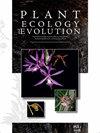大戟科植物的叶片形态空间可能是由进化偶然性而非气候形成的
IF 1.1
4区 生物学
Q3 PLANT SCIENCES
引用次数: 2
摘要
背景和目的——了解植物属性的变化主要是由选择还是历史偶然性驱动是进化生物学的主要目标。我们描述了山雀的叶片多样性,并确定了与分类学、地理、生物地理学和气候相关的模式,这些模式为生态和进化力量在形成其叶片多样性中的作用提供了见解。材料和方法——我们使用从图像(叶片最大长度和宽度、面积和周长)导出的线性形态测量,并计算反映叶片形状各方面的指数(叶片长宽比、面积周长比、倒卵形指数和圆形度),构建了叶片形态空间。气候数据是根据发生数据从WorldClim层中提取的。我们通过主成分分析可视化了叶片和气候空间,并使用Kruskal-Wallis检验、线性模型和Mantel检验来检验叶片变异的预测因子(分类学、地理、气候)。关键结果——我们记录了山雀亚种所占据的叶片形态空间的差异,以及它们所占据的气候空间的显著重叠,这表明亚种之间的叶片差异不太可能是由气候驱动的。叶片形态可以作为山毛菜亚种的代表,因为分类学解释了叶片形态的很大一部分变化(10-60%)。地理和气候解释了一小部分亚种无法解释的叶片变异(分别为约3%和5%)。温度、降水和季节性是最具解释力的气候变量。结论——山毛藻的叶片多样性不是由气候驱动的,相反,它很可能是该物种在整个加勒比盆地的历史范围扩张过程中面临的进化偶然性的结果。这项研究表明,除了影响生态过程的选择外,历史偶然性还可以塑造叶片多样性,并扩大谱系探索形态和气候空间的潜力。本文章由计算机程序翻译,如有差异,请以英文原文为准。
Leaf morphospace in Euphorbia tithymaloides (Euphorbiaceae) was likely shaped by evolutionary contingencies rather than climate
Background and aims – Understanding whether variation in plant attributes is primarily driven by selection or historical contingencies is a main goal in evolutionary biology. We characterize leaf diversity in Euphorbia tithymaloides and identify patterns related to taxonomy, geography, biogeography, and climate that provide insights on the role of ecological and evolutionary forces in shaping its leaf diversity.
Material and methods – We constructed a leaf morphospace using linear morphometric measurements derived from images (leaf maximum length and width, area, and perimeter), and calculated indexes that reflect aspects of leaf shape (leaf aspect ratio, area-perimeter ratio, obovate index, and circularity). Climatic data were extracted from WorldClim layers based on occurrence data. We visualized leaf and climate spaces with principal components analyses and used Kruskal-Wallis tests, linear models, and Mantel tests to test predictors of leaf variation (taxonomy, geography, climate).
Key results – We document differences in the foliar morphospace occupied by subspecies of Euphorbia tithymaloides, and a substantial overlap in the climatic space they occupy, suggesting that foliar differences among subspecies are not likely driven by climate. Foliar morphology can be used as a proxy for subspecies in E. tithymaloides, as taxonomy explains a large proportion of variation in leaf morphology (10–60%). Geography and climate explain a small proportion of foliar variation not explained by subspecies (~3% and 5%, respectively). Temperature, precipitation, and seasonality are the climate variables with most explicative power.
Conclusion – Leaf diversity in E. tithymaloides is not driven by climate, instead, it is likely the result of evolutionary contingencies faced by this species throughout its historical range expansion across the Caribbean Basin. This study shows that historical contingencies in addition to selection acting on ecological processes can shape foliar diversity and expand a lineage’s potential to explore morphological and climatic spaces.
求助全文
通过发布文献求助,成功后即可免费获取论文全文。
去求助
来源期刊

Plant Ecology and Evolution
PLANT SCIENCES-
CiteScore
2.20
自引率
9.10%
发文量
27
审稿时长
>12 weeks
期刊介绍:
Plant Ecology and Evolution is an international peer-reviewed journal devoted to ecology, phylogenetics and systematics of all ‘plant’ groups in the traditional sense (including algae, cyanobacteria, fungi, myxomycetes), also covering related fields.
The journal is published by Meise Botanic Garden and the Royal Botanical Society of Belgium.
 求助内容:
求助内容: 应助结果提醒方式:
应助结果提醒方式:


